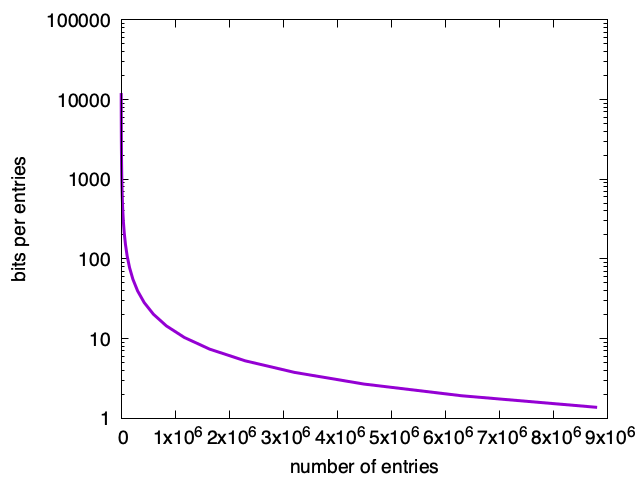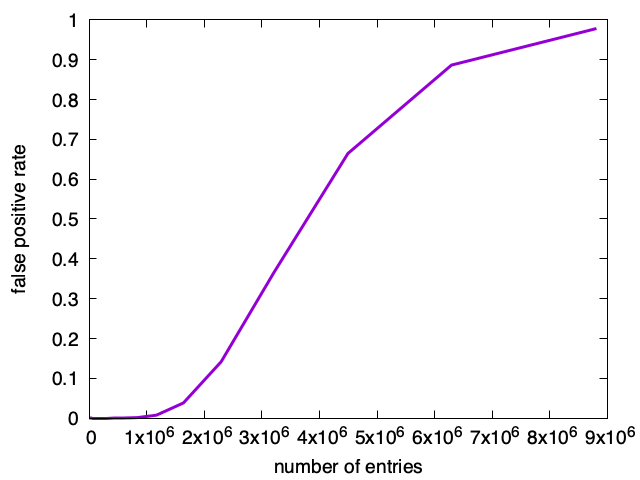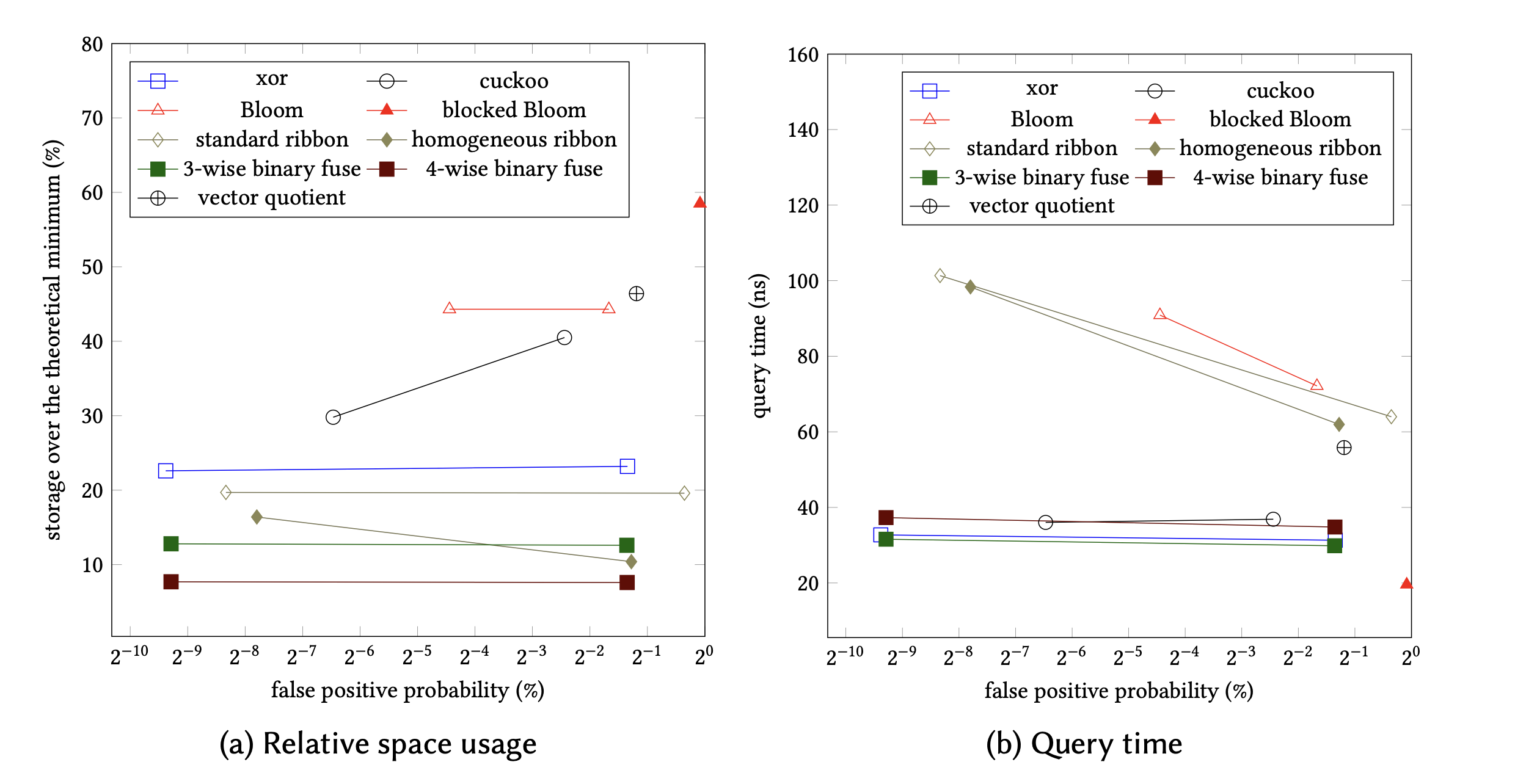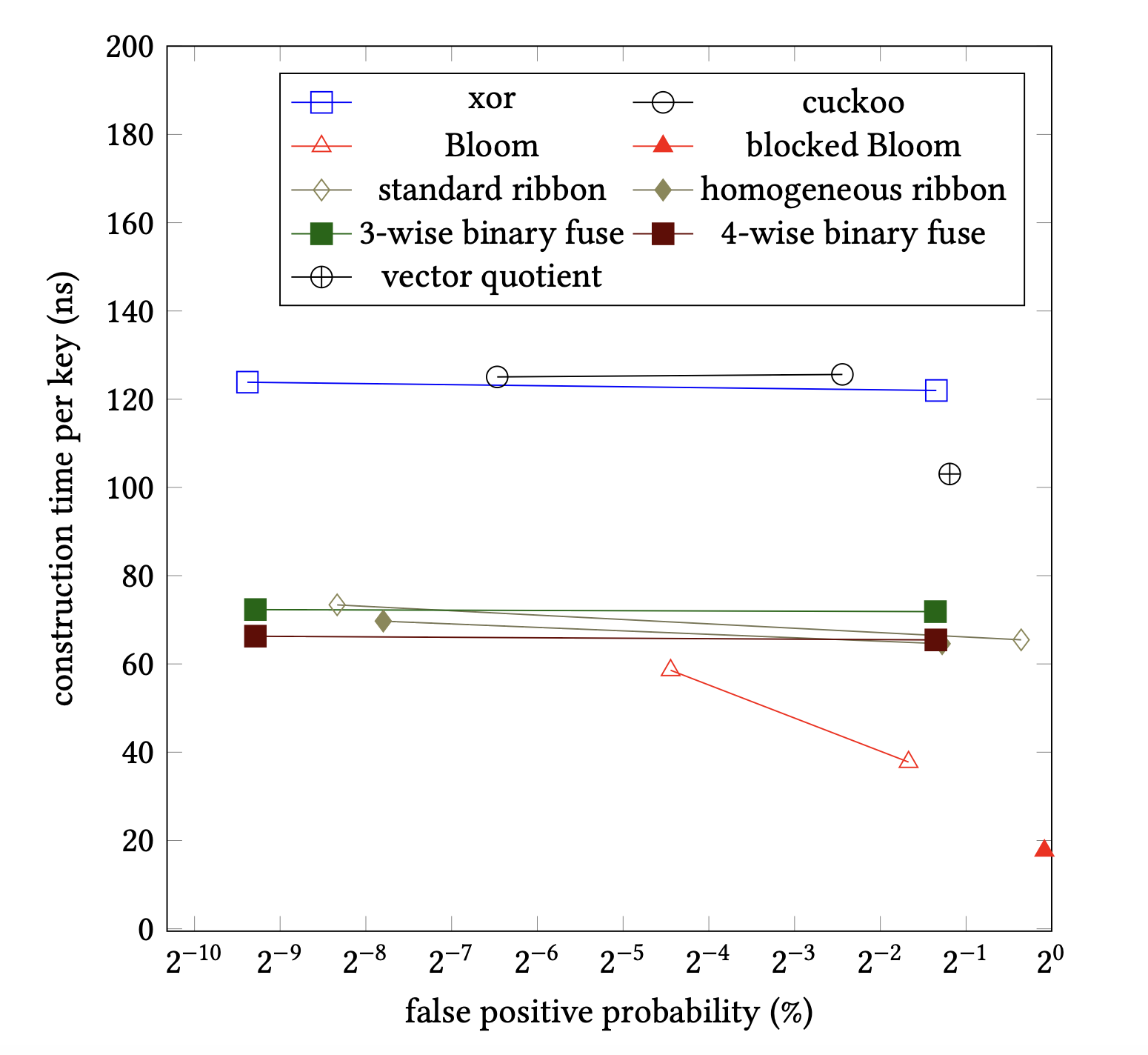Usage scenario?
- We have this expensive database. Querying it cost you.
- Most queries should not end up in the data.
- We want a small 'filter' that can prune out queries.
Theoretical bound
- Given
- Spend
- Get a false positive rate of
Usual constraints
- Fixed initial capacity
- Difficult to update safely without access to the set
- To get a 1% false-positive rate:
Hash function
- From any objet in the universe to a word (e.g., 64-bit word)
- Result looks random
uint64_t murmur64(uint64_t h) {
h ^= h >> 33;
h *= UINT64_C(0xff51afd7ed558ccd);
h ^= h >> 33;
h *= UINT64_C(0xc4ceb9fe1a85ec53);
h ^= h >> 33;
return h;
}
Conventional Bloom filter
- Start with a bitset
- Using
khash functions
Adding an element
- Given an object
kbits to 1
Checking an element
- Given an object
kbits to 1
Checking an element: implementation
- Typical implementation is branchy
- If not
- If not
- ...
- return true
uint64_t hash = hasher(key);
uint64_t a = (hash >> 32) | (hash << 32);
uint64_t b = hash;
for (int i = 0; i < k; i++) {
if ((data[reduce(a, length)] & getBit(a)) == 0) {
return NotFound;
}
a += b;
}
return Found;
False positive rate
| bits per element | hash functions | fpp |
|---|---|---|
| 9 | 6 | 1.3% |
| 10 | 7 | 0.8% |
| 12 | 8 | 0.3% |
| 13 | 9 | 0.2% |
| 15 | 10 | 0.07% |
| 16 | 11 | 0.04% |
Bloom filters: upsides
- Fast construction
- Flexible: excess capacity translates into lower false positive rate
- Degrades smoothly to a useless but 'correct' filter


Bloom filters: downsides
- 44% above the theoretical minimum in storage
- Slower than alternatives (lots of memory accesses)

Memory accesses
| number of hash functions | cache misses (miss) | cache misses (hit) |
|---|---|---|
| 8 | 3.5 | 7.5 |
| 11 | 3.8 | 10.5 |
(Intel Ice Lake processor, out-of-cache filter)
Mispredicted branches
| number of hash functions | all out | all in |
|---|---|---|
| 8 | 0.95 | 0.0 |
| 11 | 0.95 | 0.0 |
(Intel Ice Lake processor, out-of-cache filter)
Performance
| number of hash functions | always out (cycles/entry) | always in (cycles/entry) |
|---|---|---|
| 8 | 135 | 170 |
| 11 | 140 | 230 |
(Intel Ice Lake processor, out-of-cache filter)
Blocked Bloom filters
- Same as a Bloom filters, but for a given object, put all bits in one cache line
- Optional: Use SIMD instructions to reduce instruction count
Blocked Bloom filters: pros/cons
- Stupidly fast in both construction and queries
- ~56% above the theoretical minimum in storage
auto hash = hasher_(key);
uint32_t bucket_idx = reduce(rotl64(hash, 32), bucketCount);
__m256i mask = MakeMask(hash);
__m256i bucket = directory[bucket_idx];
return _mm256_testc_si256(bucket, mask);
Binary fuse filters
- Based on theoretical work by Dietzfelbinger and Walzer
- Immutable datastructure: build it once
- Fill it to capacity
- Fast construction
- Fast and simple queries
Arity : 3-wise, 4-wise
- 3-wise version has three hits, 12% overhead
- 4-wise version has four hits, 8% overhead
Queries are silly
- Have an array of fingerprints (e.g., 8-bit words)
- Compute 3 (or 4) hash functions:
- Compute fingerprint function (
- Compute XOR and compare with fingerprint:
bool contain(uint64_t key, const binary_fuse_t *filter) {
uint64_t hash = mix_split(key, filter->Seed);
uint8_t f = fingerprint(hash);
binary_hashes_t hashes = hash_batch(hash, filter);
f ^= filter->Fingerprints[hashes.h0] ^ filter->Fingerprints[hashes.h1] ^
filter->Fingerprints[hashes.h2];
return f == 0;
}
| cache misses | mispredictions | |
|---|---|---|
| 3-wise binary fuse | 2.8 | 0.0 |
| 4-wise binary fuse | 3.7 | 0.0 |
(Intel Ice Lake processor, out-of-cache filter)
| always out (cycles/entry) | always in (cycles/entry) | bits per entry | |
|---|---|---|---|
| Bloom |
135 | 170 | 12 |
| 3-wise bin. fuse | 85 | 85 | 9.0 |
| 4-wise bin. fuse | 100 | 100 | 8.6 |
(Intel Ice Lake processor, out-of-cache filter)

Construction 1
- Start with array for fingerprints containing slightly more fingerprints than you have elements in the set
- Divide the array into segments (e.g., 300 disjoint)
- Number of fingerprints in segment: power of two (hence binary)
Construction 2
- Map each object
- The locations should be in three consecutive segments (so relatively nearby in memory).
Construction 3
- At the end, each location
Construction 4
- Find a location mapped from a single set element
- Record this location which is owned by
- Remove the mapping of
- Repeat
Construction 5
- Almost always, the construction terminates after one trial
- Go through the matched keys, in reverse order, adn set (e.,g.)
Construction: Performance
- Implemented naively: terrible performance (random access!!!)
- Before the construction begins, sort the elements of the sets according to the segments they are mapped to.
- This greatly accelerates the construction

How does the performance scale with size?
For warm small filters, number of access is less important.
Becomes more computational.
For large cold filters, accesses are costly.
10M entries
| ns/query (all out) | ns/query (all in) | fpp | bits per entry | |
|---|---|---|---|---|
| Bloom | 17 | 14 | 0.32% | 12.0 |
| Blocked Bloom (NEON) | 3.8 | 3.8 | 0.6% | 12.8 |
| 3-wise bin. fuse | 3.5 | 3.5 | 0.39% | 9.0 |
| 4-wise bin. fuse | 4.0 | 4.0 | 0.39% | 8.6 |
(Apple M2)
100M entries
| ns/query (all out) | ns/query (all in) | fpp | bits per entry | |
|---|---|---|---|---|
| Bloom | 38 | 33 | 0.32% | 12.0 |
| Blocked Bloom (NEON) | 11 | 11 | 0.6% | 12.8 |
| 4-wise bin. fuse | 17 | 17 | 0.39% | 9.0 |
| 4-wise bin. fuse | 20 | 20 | 0.39% | 8.6 |
(Apple M2)
Compressibility (zstd)
| bits per entry (raw) | bits per entry (zstd) | |
|---|---|---|
| Bloom |
12.0 | 12.0 |
| 3-wise bin. fuse | 9.0 | 8.59 |
| 4-wise bin. fuse | 8.60 | 8.39 |
| theory | 8.0 | 8.0 |
Sending compressed filters
Compressed (zstd) binary fuse filters can be within 5% of the theoretical minimum.
Some links
- Bloom filters in Go: https://github.com/bits-and-blooms/bloom
- Binary fuse filters in Go: https://github.com/FastFilter/xorfilter
- Binary fuse filters in C: https://github.com/FastFilter/xor_singleheader
- Binary fuse filters in Java: https://github.com/FastFilter/fastfilter_java
- Giant benchmarking platform: https://github.com/FastFilter/fastfilter_cpp
Other Links
- Blog https://lemire.me/blog/
- Twitter: @lemire
- GitHub: https://github.com/lemire